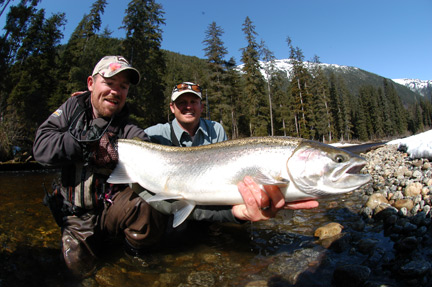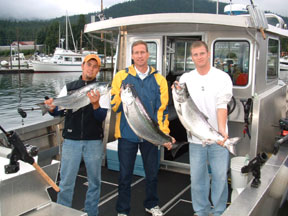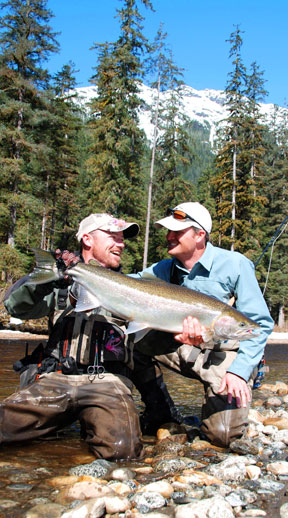Tongass National Forest

Credit: Ian Davis, Yellow Dog Fly Fishing Adventures
The Tongass: America’s Salmon Forest
“The Tongass is America’s salmon forest and one of the few places in the world where wild salmon and trout still thrive.
“Some 65 percent of Tongass salmon and trout habitat is not Congressionally protected at the watershed scale, and is currently open to development activities that could harm fish.
“It’s time for Congress to better protect the richest resource of the Tongass: wild salmon.”
Tim Bristol
Trout Unlimited, Alaska Program Director
Visit the new American Salmon Forest web site today.
Restoring America's Salmon Forest
Check out this video from the Sitka Conservation Society about the restoration project at the Sitkoh River, aimed to improve salmon habitat in the Tongass National Forest.
TRCP's Conservation Field Notes
Steven Rinella emphasizes the value of undeveloped winter range for Sitka black-tailed deer in southeastern Alaska’s Tongass National Forest in a recent episode of TRCP's Conservation Field Notes.
Fate of the Tongass is a short video about Southeast Alaska and the challenges of multiple-use management of the forest.
Fate of the Tongass from jeremy williams on Vimeo.
The US Forest Service has produced a nice video about the Tongass from the perspective of USFS employees working in various positions around the Tongass.
steelhead_on_n.jpg)
Naha Steelhead, ©Ray Troll
At nearly 17 million acres, an area the size of West Virginia, and covering most of the archipelago that makes up southeast Alaska, the Tongass National Forest is our country’s largest national forest. In the Tongass, towering groves of Sitka spruce and western hemlock grow 200 feet tall and individual trees can live as long as 1,000 years. Nowhere else in our nation can one collectively find old-growth forest with thriving populations of wolves, black and brown bears, Sitka black-tail deer, wolverines, Bald Eagles, Northern Goshawks, five species of wild salmon, and countless other natural treasures that have disappeared from most of the American landscape. The Tongass faces a range of serious and urgent threats including large-scale clearcut logging of old growth, land transfers and industrial-scale tourism. In just the past 50 years alone, industrial logging has destroyed approximately 750,000 acres of this pristine forest and the majority of its biggest and best stands of old-growth forest. The Forest Service’s 10-year timber sale schedule includes over 50 sales in roadless areas that were previously protected by the Roadless Area Conservation Rule.
Click here to read an article by David Oakes of Dallas Safari Club about the field trip organized by SAA that brought delegates from leading hunting conservation groups to Southeast Alaska in the summer of 2007 to learn about management of the Tongass National Forest (PDF File Size 1273 k).

Coho (Silver) Salmon, ©Mark Kaelke
Alaska Rainforest Fishing
The Alaska rainforest is an angler's dream come true. Forest streams offer the chance to challenge heart-stopping runs of giant king salmon, rainbow trout the length of your arm, and fighting steelhead. Fifty-pound king salmon are not uncommon, though the record was a 126-pounder caught near Petersburg in the early 1900s. Off the scenic coast, halibut are popular sport fish as well. In addition to countless backcountry opportunities, fishermen are served by a variety of lodges and charter services which provide experiences unavailable elsewhere in the world.
Alaska Rainforest Hunting
Alaska still offers a rich variety of big game for hunters to pursue. Grizzly and black bears browse on forest understory shrubs and gorge on summer salmon runs. Rainforest grizzlies regularly reach over 1,400 pounds. Mountain goats guard the forest's rocky peaks, taking cover in the high forest edge during the long winter. The Alaska rainforest supports the world's densest concentrations of both grizzly bears and mountain goats. Sitka black-tailed deer also rely on both the cover and food found under ancient trees to survive heavy winter snows. These medium sized deer are the mainstay for local hunters and also serve as a food source for predators such as bears and wolves. With an abundance of game and adequate habitat to support populations, Alaska is one of the last places where hunters can experience the bounties of the frontier.
For more information on the Tongass National Forest, visit www.akrain.org and www.seacc.org.
Emerging Threat to the Tongass National Forest!

Spring Steelhead Fishing in the Tongass
National Forest. (c) Ian Davis/Yellow Dog
Flyfishing Adventures
Feb. 1, 2010 – The Senate Energy and Natural Resources Committee appears poised to mark up S. 881, the Sealaska native corporation land entitlement legislation, likely sometime in March at their next business meeting.
In short, S. 881 would transfer approx. 80,000 acres of prime Tongass National Forest public lands to the regional native corporation, Sealaska.
The majority of these acres would then be subjected to intensive timber harvest, and Sealaska would be granted the opportunity to select dozens of “futures sites” at valuable locations in the Tongass – opening the door for potential expansion of larger-scale tourism operations into valuable fish and game habitats.
Check out the fact sheet on the Sealaska bill. Be ready to contact your Senators – especially if he or she is on the Energy and Natural Resources Committee.
John&Bear.jpg)
Alaska Brown Bear, ©Chris Erickson
New Management Plan for the Tongass National Forest
On January 25, 2008 the U.S. Forest Service released the new Tongass Land Management Plan. The plan sets fundamental management direction for the Tongass, and the need for the most-recent revision to the Tongass management plan stems from a court ruling in 2005. The 9th Circuit Court of Appeals ordered the Forest Service to revise the 1997 forest plan because the agency erroneously doubled its experts’ projections of market demand for Tongass timber. This error exaggerated projected logging levels and resulted in much more land being designated for timber harvest than the agency’s own economists found was necessary to supply local mills.
With the just-released plan, the Forest Service has tried something different. Instead of immediately setting high logging levels, the plan will have several phases.
Phase One: Logging would occur primarily along the existing road system, although some wild watersheds could be affected.
Phase Two: Wouldn’t kick in until the timber industry cuts more than 100 million board feet (MMBF) for two years in a row, which hasn’t happened for the last eight years. In Phase Two, many more important places and watersheds would be made available for logging.
Phase Three: Would begin if the industry logged over 150 MMBF for two years in a row. In this case, the timber map would look pretty much as it did before the new plan, with an Allowable Sale Quantity of 267 MMBF.
Two valuable areas, Goose Flats in upper Tenakee Inlet and Bostwick Inlet on Gravina Island, have been moved out of the timber base altogether. The plan will delay logging in important places like the Cleveland Peninsula, much of Upper Tenakee Inlet, and Port Houghton. The decision to defer logging and road building in some of the most valuable fish and wildlife watersheds on the Tongass buys time and reflects a new science-based study by Audubon and The Nature Conservancy that identified conservation priorities for intact watersheds throughout the Tongass. This plan shows that the Forest Service is starting to recognize there are valuable places that both residents of the region and visitors to the Tongass depend on for a wide range of uses.
The plan is generally viewed as an improvement in some areas, but it isn’t perfect. The new plan fails to permanently protect some important areas which are still targeted for eventual logging. In addition, core areas of old-growth forest in some previously logged watersheds should be protected rather than targeted for further logging. In the long term, implementation of this plan will place at risk many of the most important fish and wildlife values that people care about. We will still need to be vigilant to protect special areas that remain slated for logging, such as northern Kuiu Island, Castle River, and parts of Gravina Island. But this “phased” plan gives some breathing room for the various user groups to work together to achieve a long-term balance of healthy and diverse communities, vibrant economies, protection of valuable wildlands, and responsible sustainable use of our largest national forest.
The Sportsman’s Alliance for Alaska supports balanced forest management that recognizes all of the important values the Tongass provides to the people of southeast Alaska and visitors to the region, including subsistence use of resources, hunting and fishing, recreation, and economic sustainability of local communities. The SAA encourages all user groups to continue working collaboratively with the Forest Service, other organizations, and local communities to develop a science-based conservation strategy that balances habitat protection with local community needs, and find a practical way forward that delivers results for everyone who depends on the Tongass.






